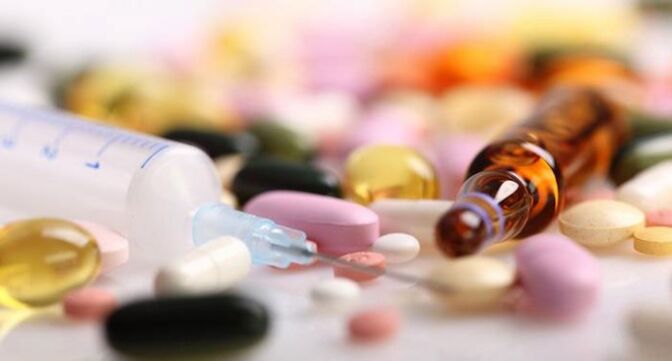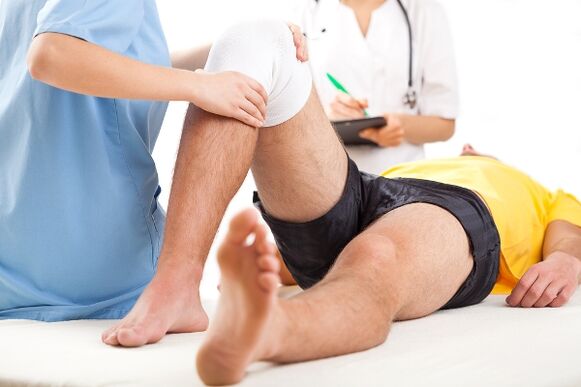
Pathological causes and risk factors
- Joint injuries (fractures, meniscal injuries, ligament ruptures, dislocations, compression + contusions, fractures).
- Dysplasia (abnormal intrauterine development of joint components).
- Violation of substance metabolism.
- Autoimmune pathologies (rheumatoid arthritis, psoriasis, autoimmune toxic goiter, systemic lupus erythematosus).
- Nonspecific destructive arthritis (with purulent component).
- Infections of various causes (tuberculosis, meningitis, encephalitis, gonorrhea, syphilis, hepatitis).
- Pathology of the endocrine glands (diabetes, toxic goiter, pathology of the adrenal and pituitary glands).
- Hormonal dysfunction (lower levels of estrogen and androgens).
- Degenerative + malnutrition reactions (multiple sclerosis, Perthes disease).
- Oncological diseases.
- Blood disorders (hemophilia, anemia, leukemia).
- Age-related changes.
- Obesity (excess weight leads to continuous vertical loads that overload the joints, which wear out quickly and the cartilage plates fall off).
- Specialized cost, which is the loading of one group of joints causing inflammation or premature destruction before others.
- Postoperative consequences: Highly invasive surgery to remove affected tissue (soft tissue, cartilage tissue, bone tissue). The joint structures do not have the same consolidation after restorative procedures, so any load can lead to arthropathy.
- A genetic factor, called joint disease, can affect one or more family members.
- Hormonal imbalance during menopause or after ovarian removal in women and prostate removal in men.
- Violation of water-salt balance.
- Neurodystrophic damage to the spine is a trigger for arthritis in the glenohumeral, lumbosacral, and hip joints.
- Pesticide and heavy metal poisoning.
- Sudden changes in temperature coupled with hypothermia.
- Causes permanent trauma to a group of joints.
Mechanisms of joint development
Stages of clinical manifestations of joint pathology: Stages
- Phase I:There are no special morphological changes, the nutritional function is not disturbed, and the synovial fluid production is sufficient. The stability of the joint structure corresponds to the average body activity. Pain and swelling occur in the joints due to forced labor.
- second stage:Loss of the cartilage plate, development of lesions of osteophytic islands, and ossification along the joint edges were observed. Pain syndrome worsens, swelling increases, and movement discomfort occurs. As the pathology progresses to the chronic stage, pain persists and is associated with inflammation, accompanied by periods of exacerbation/remission. The biomechanics are partially compromised and the patient retains the joint.
- The third phase:The cartilage plate is completely worn away; the bone ends form osteophytes + false fixation of the interosseous joint system instead of cartilage. The anatomical shape is completely destroyed. Joint ligaments and muscles shorten and thicken. The slightest injury can result in dislocations, fractures, and cracks. The nutritional function of the locomotor organs is impaired, so the required amounts of blood and nutrients are not available. A pinched nerve can cause a severe pain response that only goes away after taking strong painkillers or drugs from the COX1/COX2 group.
joint pain syndrome

attention!Blockade pain can only be treated through surgical intervention followed by repair of the affected joint. Treatment with folk remedies is not recommended, it leads to the development of septic joint disease, the infection spreads throughout the body, and after sepsis, significant morphological changes occur in all organs and systems.
symptoms of joint inflammation
| Degree and stage of joint disease | Symptom description |
|---|---|
| I save |
|
| Level 2 |
|
| Level three |
|
| Exacerbation and remission periods | In arthropathy, exacerbations alternate with remissions. Physical activity exacerbates pathological changes. Exacerbations are caused by synovitis. The pain syndrome covers all affected areas, including muscle bundles. It spasms reflexively, forming painful contractures. Arthropathy is characterized by muscle spasms. As the damage increases, the pain syndrome becomes more pronounced. In reactive synovitis, the joints become enlarged and take on a spherical shape. The presence of fluid in the joints produces a rippling effect when palpated. During a brief period of relief, the pain is reduced, but movement is difficult. |
diagnostic measures
- General and biochemical blood tests.
- Blood tests for rheumatoid medications.
- Urine and stool analysis.
- X-ray examination: images from three locations.
- CT scan of joints to identify bone structure.
- MRI of joints: study of ligaments and muscles.
- CT examination.
important!Patients with joint disease need to consult an orthopedic surgeon, rheumatologist, endocrinologist, hematologist, oncologist, and female patients are advised to consult a gynecologist.
Treatment programs

Medication Treatment for Arthritis
- Drugs from the NSAID group;
- Painkillers (tablets + injections);
- Medications to relieve muscle spasms (muscle relaxants);
- Cartilage tissue restorer (chondroprotectant);
- antibiotic;
- antihistamines;
- Medications to improve blood circulation;
- Vitamins: B2, B12, PP and A;
- Antioxidants: Vitamin C;
- Medications based on hormonal substances.
- Gold-based medicines;
- immunosuppressants;
- antimalarial drugs;
- Drugs that inhibit malignant cells.
attention!During the period of pathological remission, the use of nonsteroidal anti-inflammatory drugs is not recommended; they affect the gastrointestinal tract, cause massive ulcers, and also inhibit the nutritional processes of cartilage tissue.
Topical ointment for arthritis
physiotherapy

Surgery
folk remedies
- Garlic tincture + onion honey: 100 grams of garlic paste + 100 grams of chopped onions + 2 tablespoons of honey + 200 ml of vodka. Infusion for 3-5 days. Apply as a dab and rub in.
- Sabelnik tincture form: 200 g of dry powder or fresh gruel + 200 ml of diluted medicinal alcohol, left for 24 hours. Drink one spoonful 3 times a day before meals.
- Ointment based on badger fat and propolis: rub on joints twice daily.
- Edible horseradish + honey: 100g horseradish + 100g honey + 100ml vodka. Infuse for 24 hours and drink 20 drops. This tincture can be applied to sore joints 3-5 times a day.
- Chili oil + lard: 1 teaspoon powder + 200 grams of lard. Infuse for 2-3 days. Used as a warming and tonic local medicine. Apply 1-2 times daily.
- Compression: oak bark + spruce needles: 200 grams of oak bark + 200 grams of crushed spruce needles + 100 ml of alcohol.
Prevention features
- Adjust the menu to exclude fried, fat, pepper, salty, alcohol + nicotine.
- Add jellies and jellies to your daily menu.
- Avoid tiring loads.
- Take safety precautions to avoid injury.
- Continuously perform a special set of exercises on the motor system.
- Try taking vitamins B and C.
- For prevention purposes, take chondroprotectants, calcium, potassium supplements, and other minerals every six months.
- After a joint sprain or mechanical injury, get checked by a doctor.































